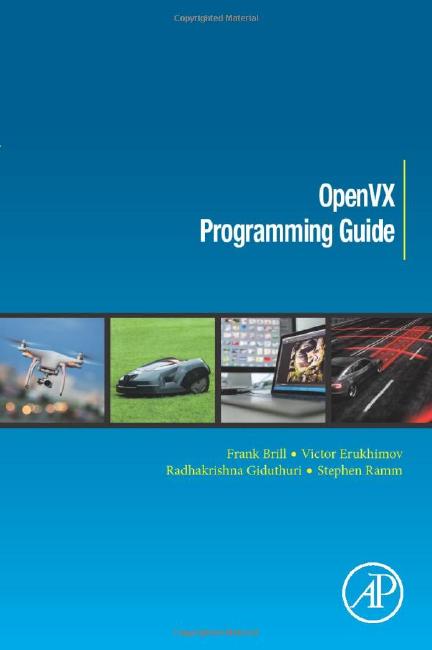Academic Press OpenVX Programming Guide 1st edition by Frank Brill,Victor Erukhimov,Steve Ramm,Radhakrishna Giduthuri 0128164255 9780128164259
$70.00 Original price was: $70.00.$35.00Current price is: $35.00.
Instant download Academic Press OpenVX Programming Guide after payment
Academic Press OpenVX Programming Guide 1st edition by Frank Brill,Victor Erukhimov,Steve Ramm,Radhakrishna Giduthuri – Ebook PDF Instant Download/Delivery:0128164255,9780128164259
Full dowload Academic Press OpenVX Programming Guide 1st edition after payment

Product details:
ISBN 10:0128164255
ISBN 13:9780128164259
Author:Frank Brill,Victor Erukhimov,Steve Ramm,Radhakrishna Giduthuri
OpenVX is the computer vision API adopted by many high-performance processor vendors. It is quickly becoming the preferred way to write fast and power-efficient code on embedded systems. OpenVX Programming Guidebook presents definitive information on OpenVX 1.2 and 1.3, the Neural Network, and other extensions as well as the OpenVX Safety Critical standard.
This book gives a high-level overview of the OpenVX standard, its design principles, and overall structure. It covers computer vision functions and the graph API, providing examples of usage for the majority of the functions. It is intended both for the first-time user of OpenVX and as a reference for experienced OpenVX developers.
- Get to grips with the OpenVX standard and gain insight why various options were chosen
- Start developing efficient OpenVX code instantly
- Understand design principles and use them to create robust code
- Develop consumer and industrial products that use computer vision to understand and interact with the real world
Academic Press OpenVX Programming Guide 1st Table of contents:
Chapter 1: Introduction
Abstract
1.1. What is OpenVX and why do we need it?
1.2. Portability
1.3. OpenVX data objects
1.4. Graph API
1.5. Virtual objects
1.6. Deep neural networks
1.7. Immediate mode API
1.8. OpenVX vs. OpenCV and OpenCL
1.9. OpenVX versions
1.10. Prerequisites
1.11. Code samples
References
Chapter 2: Build your first OpenVX program
Abstract
2.1. First things first
2.2. Immediate mode
2.3. Graph mode
2.4. Image input and output
References
Chapter 3: Building an OpenVX graph
Abstract
3.1. Linking nodes
3.2. Virtual images
3.3. Graph verification and execution
3.4. Parameter validation
3.5. What can be changed at runtime?
3.6. Example
Chapter 4: Using the graph API to write efficient portable code
Abstract
4.1. OpenVX graph
4.2. Node parameters
4.3. Graph parameters
4.4. Execution model
4.5. Control flow
4.6. User kernels and nodes
4.7. The OpenVX pipelining extension
Chapter 5: Deploying an OpenVX graph to a target platform
Abstract
5.1. Graph factories
5.2. The XML extension
5.3. The export and import extension
References
Chapter 6: Basic image transformations
Abstract
6.1. OpenVX image object
6.2. Image filtering
6.3. Regions of interest
6.4. Feature extraction
6.5. Geometric image transformations
References
Chapter 7: Background subtraction and object detection
Abstract
7.1. A threshold-based object detector
7.2. Adding alpha blending to the background model
7.3. Applying morphology operators to the foreground
Chapter 8: Computational photography
Abstract
8.1. Naïve image blending
8.2. Obtaining intermediate results
8.3. Multiband image blending
8.4. Building a Gaussian pyramid for the blending weights
8.5. Implementing Laplacian pyramid functions with OpenVX graph
References
Chapter 9: Tracking
Abstract
9.1. Introduction
9.2. Tracking methods
9.3. Optical flow
9.4. The aperture problem
9.5. The Lucas–Kanade algorithm for sparse feature sets
9.6. Bouguet’s implementation using image pyramids
9.7. Selection of features to track
9.8. Centroid tracking
9.9. Example of tracking using OpenVX
9.10. Multiple objects
9.11. Occlusion and trajectories
9.12. The mirror ball and other failings of our algorithm
9.13. Image stabilization, panning, and zooming
References
Chapter 10: Neural networks
Abstract
10.1. OpenVX neural network extension
10.2. Inserting an entire neural network into an OpenVX graph as a single node
10.3. NNEF: the Khronos neural network exchange format
10.4. Import NNEF models into OpenVX
Chapter 11: OpenVX safety-critical applications
Abstract
11.1. Safety-critical applications and standards
11.2. What is in these standards?
11.3. What could possibly go wrong?
11.4. Errors and avoiding them
11.5. How to do agile development and still meet the ISO26262 requirements
11.6. Determinism
11.7. OpenVX-SC
11.8. Programming with C++
11.9. Data objects
11.10. A practical example
11.11. Learning and modification of software in safety-critical systems
References
Chapter 12: Efficient data input/output
Abstract
12.1. Introduction to efficient data I/O in OpenVX
12.2. Efficient data I/O from and to external sources
12.3. Gaining access to data objects via map and unmap
12.4. Conclusion
Chapter 13: Interoperability between OpenVX and other frameworks
Abstract
13.1. OpenCV
13.2. OpenCL
References
Chapter 14: Existing implementations and platforms for OpenVX
Abstract
14.1. CPU implementations
14.2. DSP implementations
14.3. GPU implementations
14.4. Special-purpose hardware implementations
14.5. FPGA implementations
14.6. Hybrid System-on-Chips (SoCs)
Chapter 15: Changes in OpenVX 1.3
Abstract
15.1. Feature sets
15.2. Safety-critical application support
15.3. Removal of bidirectional parameters
15.4. User structures
15.5. Miscellaneous changes
References
Appendix A: The list of OpenVX data objects and their attributes
Appendix B: The list of computer vision graph API nodes
B.1. Image arithmetics and control flow
B.2. Image format conversions
B.3. Image filtering and statistics
B.4. Geometric transformations
B.5. Feature extraction
B.6. Tensor functions
People also search for Academic Press OpenVX Programming Guide 1st:
launch school open bookshelf
cs50x lecture 1
classical academic press grammar
vanguard academy professional development


